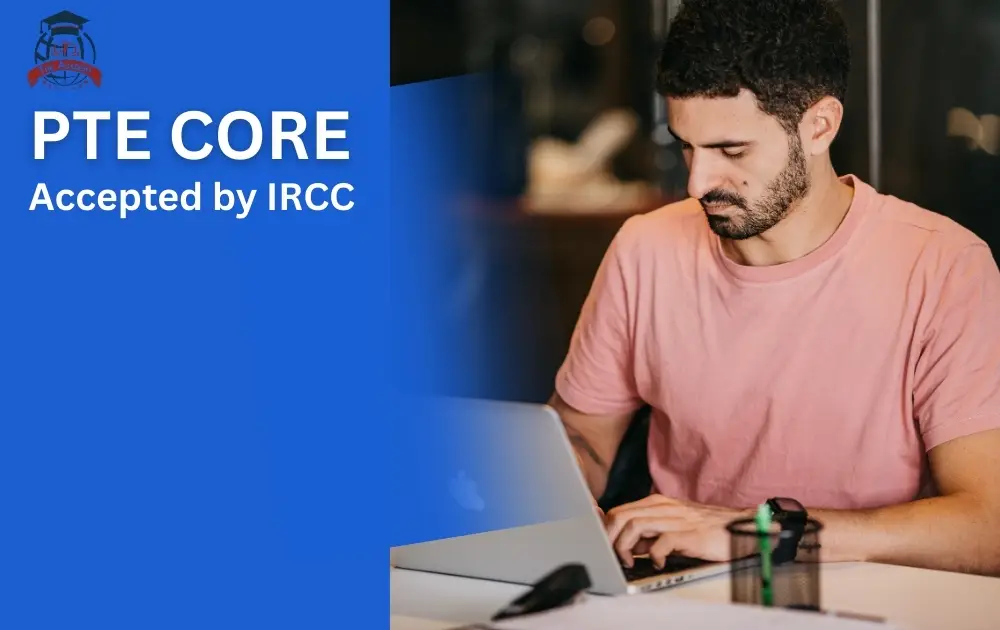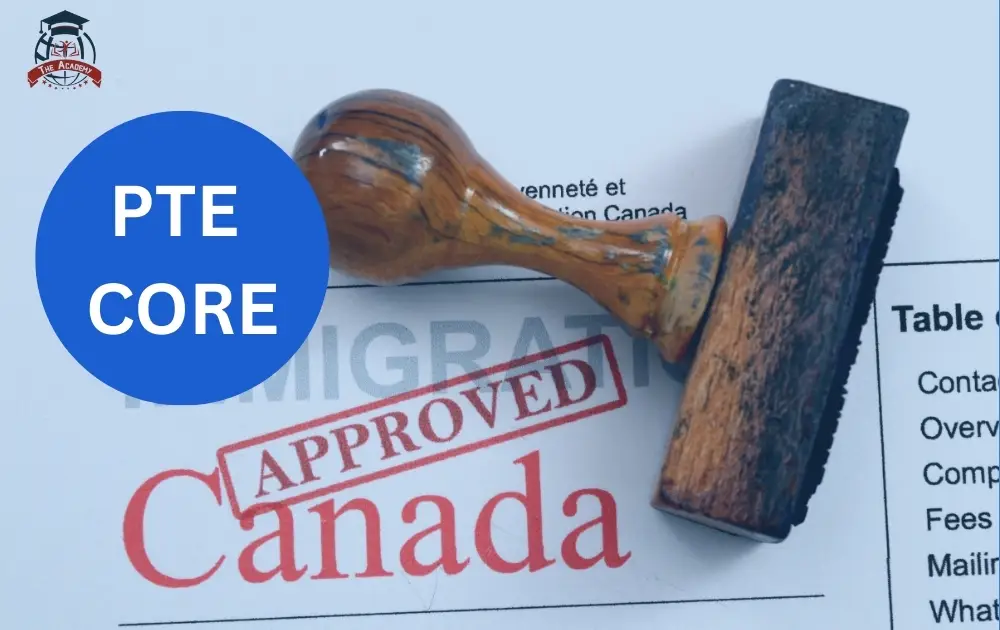PTE Core Explained: Why Pearson Created This Exam for IRCC and Canadian Immigration
PTE Core has been introduced by Pearson as a newer English language assessment developed to evaluate a person’s general (non-academic) English skills in everyday contexts, rather than the more formal academic English skills tested in PTE Academic.
The test is particularly designed for people who are looking for immigration, work, or settlement purposes in Canada. PTE Core is approved by Immigration, Refugees and Citizenship Canada (IRCC) for various visa and citizenship pathways and categories.

PTE Core with Table of Contents
What is PTE Core ?
In contrast to PTE Academic, which targets students preparing for university, PTE Core focuses on language as used in real life conversations, emails, interactions, general reading and listening tasks. Its goal is to test how effectively you can communicate in day to day English.
PTE Core was officially launched in early 2024 (around February) as a replacement/alternative to some existing general English tests in some immigration pathways.
Because it is relatively new, the test format and patterns are still being refined, and some materials and sample tasks are emerging. Below is a current snapshot of what we know so far.
Overall Format, Duration & Structure
- The test is totally computer-based, with audio headset, and a secure exam environment.
- The total duration is roughly 1 hour 45 minutes to 2 hours (roughly 105 to 120 minutes), slightly shorter than older 2+ hour versions.
- The test is divided into three parts:
1. Speaking & Writing
2. Reading
3. Listening
Some tasks integrate skills, e.g. reading & writing combined, listening & writing, etc.
Part 1:Speaking & Writing
This part of the test is 50 minutes long with seven different question types. It is the longest part of the test and you will be assessed in Speaking and writing in the English which you use on daily basis and working environment.
Question Types of Speaking and Writing
1. Personal Introduction
This question does not contribute to your score and is for familiarization purposes only. The Personal Introduction is an opportunity for you to get familiar with PTE test technology and to help you prepare for your speaking and listening questions.
You will have 25 seconds to read the prompt and prepare your response, and then 30 seconds to record your response. You are only able to record your answer once.
2. Read Aloud
In this task, You will see some text and Read the text aloud.
Length of this prompted text is up to 60 words. In this task Reading and Speaking skills are assessed. The time to answer is different and depends on the length of text.
3. Repeat Sentence
Listen to a recording of a sentence. Then repeat the sentence. Prompt length is between 3-9 seconds with skill assessment in Listening and Speaking with in 40 seconds of time to answer.
4. Describe Image
You will see an image. Describe the image in detail. In this task length of the answer is not defined, Speaking skills is assessed with in 40 seconds of time to answer.
5. Respond to a Situation
Listen to and read a description of a situation. Then answer a question about it with an extended response. the prompt length of the text is up to 60 words. Speaking skills is assessed in 40 seconds.
6. Answer Short Question
Listen to a question. Then answer with a single word or a few words. with in 3-9 seconds of prompt length for both listening and speaking to be assessed in 10 seconds.
7. Summarize Written Text
Read the text. Then write a short 25–50 word summary. of up to 200 words in 10 minutes for Reading and Writing assessment.
8. Write Email
Read the text. Then write an email in response. The prompted text is up to 100 words and used for writing skill assessment.
Time to Answer
9 minutes

Part 2:Reading
This part of the test is 30 minutes long approximately and contains five different question types. Because PTE Core is an integrated skills test, one question type (‘Reading and Writing: Fill in the blanks’) also assesses writing skills.
Question Types
1. Reading & Writing: Fill in the Blanks
You will see some text with several gaps. Choose the correct words from the drop-down boxes to fill in the gaps. The text would be up to 200 words. Reading and writing skills are assessed in this task.
2. Multiple Choice, Multiple Answers
Read the text to answer a multiple-choice question on the content or tone of the text. You can select more than one response. Prompted text length is up to 275 words and Reading Skill is assessed in this task.
3. Reorder Paragraph
You will see text boxes in a random order. Put the text in the correct order. in this task prompted text is up to 110 words. Reading skills is assessed in this type of questions.
4. Fill in the Blanks
You will see some text with several gaps. Drag words from the box below to fill the gaps. Reading skills is assessed with text up to 80 words.
5. Multiple Choice, Single Answer
Read the text. Then answer a multiple-choice question on the content or tone of the text. You can select only one response. Reading skills is assessed in given text of 110 words.
Part 3: Listening
This part of the test is approximately 30 minutes long and contains seven different question types. The questions are based on audio or video clips, which begin to play automatically. You hear each audio or video clip once. You are allowed to take notes.
Question Types
1. Summarize Spoken Text
Listen to a recording. Then write a 20–30 word summary. the length of the recording is 45 – 75 seconds, in this task is used to assess Listening and writing in 8 minutes.
2. Multiple Choice, Multiple Answers
Listen to a recording. Answer a multiple-choice question on the content or tone of the recording. You can select more than one response. Prompted length of the test is 50-90 seconds to assess the listening skill.
3. Fill in the Blanks
You will see a transcript of a recording with several gaps. Listen to the recording and type the missing word in each gap. This 30-60 length prompt is used to assessed in listening ans writing.
4. Multiple Choice, Single Answer
Listen to a recording. Select the paragraph that best summarizes the recording. Listening Skill is assessed in prompted length of 30-60 seconds recording.
5. Select Missing Word
Listen to a recording. Then select the missing word that completes the recording from a list of options. in 20-70 seconds listening skills is assessed.
6. Highlight Incorrect Words
You will see a transcript of a recording. While listening to the recording, click on the words that are different from what is said. the prompt length is 15-50 seconds with both skills assessment of listening and reading.
7. Write from Dictation
Listen to a recording of a sentence. Then type the sentence. This is 3-5 seconds prompt to assess listening and writing.
Preparation Strategies for PTE Core
PTE Core is relatively new and draws from multiple integrated skills, here are recommended strategies:
- Familiarize with task types: Make sure you fully understand each question type, including newer ones like “Respond to a Situation” and email writing.
- Practice under timed conditions: Simulate full tests to build stamina and pacing over 1 h 45–2 h.
- Work on integrated skills: Many tasks combine reading + writing, listening + writing, so practice integrating skills rather than isolating them.
- Focus on clarity and coherence: Because the test rewards clarity, avoid overly long or complex sentences if they degrade readability.
- Improve vocabulary and collocations: In short tasks, precise word choice matters more than length.
- Develop listening note-taking techniques: In listening tasks, you won’t be able to replay; good notes help you capture details.
- Mock tests and reviewing mistakes: Use mock tests, review errors carefully, and understand why an answer was wrong.
- Avoid over-reliance on templates: If the scoring system or human review flags repetitive template use, responses may be downgraded.
- Stay updated on format changes: Because PTE Core is evolving, check official Pearson announcements and test center updates prior to taking the exam.
Useful Preparation Portals
There are PTE Core question banks and AI-scored mock tests offered by platforms like Pearson’s official website and The academy’s digital portal. The preparation at Pearson’s official website is free and only requires a sign up. Pearson also offers learning by skills and question types to create more understanding with all type of questions and how to attempt them. there is no need to book the test upfront to prepare the test and the Pearson offers dedicated preparation services in Listening, Reading, writing and speaking for every test taker.
The academy is integrated with tcy’s digital portal for preparation of PTE-Core. This offers easy and simple signup to make own portal and select the desired course.
Changes & Updates (2025)
PTE Core has been introduced at the most recent times in the last year, so it has already improved and done some adjustments. One considerable change is a little reduction in test length which is reduced from over 2 hours to the current 1 h 45minutes –2 hours. PTE test designers are putting more efforts on the balanced performance across skills, rather than allowing weak performance in one area to be masked by strength in another.
Another update: the addition of email writing as a task (replacing a pure essay in some contexts) and constraints on summary word limits.
Because changes are still being introduced, always check Pearson’s official site or the local test center just before you register.
Strengths, Limitations & Tips for Candidates
Strengths:
- PTE Core is based on more General English, So try to focuses on practical English more relevant to daily life and workplace settings.
- PTE Core is of Shorter duration as compared to the older English proficiency tests. So it is great chance to get good score and make yourself suitable candidate for immigration.
- PTE Core is based on AI scoring system can lead to faster results.
- This is first AI based test by Pearson which is recognized by Canadian immigration authorities in Immigration and working visa applications.
Limitations / Challenges:
- Because it’s new, the sample materials are fewer than for older tests like IELTS or PTE Academic.
- Format changes may occur, which means you must stay current.
- Integrated and mixed tasks can be challenging (you can’t just excel in one skill).
- For speaking tasks, hesitation or unclear pronunciation may be penalized heavily.
Tips:
- Get use to to the test scenarios i-e (use of computer, using headset) to familiarize to the environment.
- Read instructions carefully is a must do thing for each task because all the formats differ slightly.
- Work on speaking fluently and naturally but do not try to be too fast.
- Carefully write spellings in typos in writing tasks, if you spell wrong you may lose points.
- Time management is very important don’t spend too much on one question and lose time on other questions.
- Practice summarizing short texts or audio in strict word limits.
Scoring
PTE Core is scored by computer using state-of-the-art scoring technology. Which ensures that you get a fair and accurate score, every time. There is no interaction with a human examiner during your test. This reduces the risk of human bias, making you to feel confident that only your English is being assessed and nothing else.
Guide to PTE Core scoring
Knowing that how we score each question can help you get your best possible score.
PTE Core has 19 question types:
- Some question types are scored based on your answer if it is right or wrong, such as multiple-choice questions.
- Other question types are scored on the base of additional features such as the quality of your content and whether you have completed the required word count or not.
PTE Core Score Report
Overall score and individual communicative skills scores is reported on a numerical scale of 10-90. The each skills scores will help you know your strengths and areas for improvement. Scores are always aligned to the CLB framework. Applicants for immigration to Canada should always consult the official IRCC Website to see how their scores relate to the immigration requirements.
PTE Core Score Report consists of a complete skills profile, which gives you a detailed report of your performance across each different language skill. The Profile also has personal recommendations on how to improve your English proficiency even further – valuable if you need to build your language skills in one or two areas

PTE Core Scores Comparison with (CLB) Canadian language Benchmark
If you applying for Canada after PTE Core, you will be asked for the Canadian Language Benchmark for one or more of your language skills. CLB is the standard used to describe, measure and recognize the language ability of adult immigrants and prospective immigrants who plan to live and work in Canada. Table to know can be downloaded from Pearson’s website and can be verified with IRCC website.
FAQs about PTE Core
1. What is PTE Core?
PTE Core is a computer-based English language test designed to assess everyday English skills for immigration, work, and general purposes.
2. Who accepts PTE Core?
It is accepted by the Canadian government (IRCC) and other organizations for immigration, work, and citizenship applications.
3. How is PTE Core different from PTE Academic?
PTE Core focuses on general English for migration and work, while PTE Academic is meant for university or academic admissions.
4. What is the test format?
The exam has three parts:
- Speaking & Writing (~50 minutes)
- Reading (~30 minutes)
- Listening (~30 minutes)
The total test time is about 2 hours.
5. What is the scoring system?
Scores range from 10 to 90, with results mapped to Canadian Language Benchmark (CLB) levels.
6. How long is the score valid?
PTE Core scores are valid for 2 years from the test date.
7. How fast are results available?
Results are typically available within 2 business days.
8. Can I retake the test?
Yes, you can retake PTE Core as many times as needed, but you must wait until your current results are released.
9. What identification is required?
A valid passport or government-issued ID is required on test day.
10. How can I prepare?
Use official practice tests, sample questions, and online preparation materials to familiarize yourself with the question types and timing.
